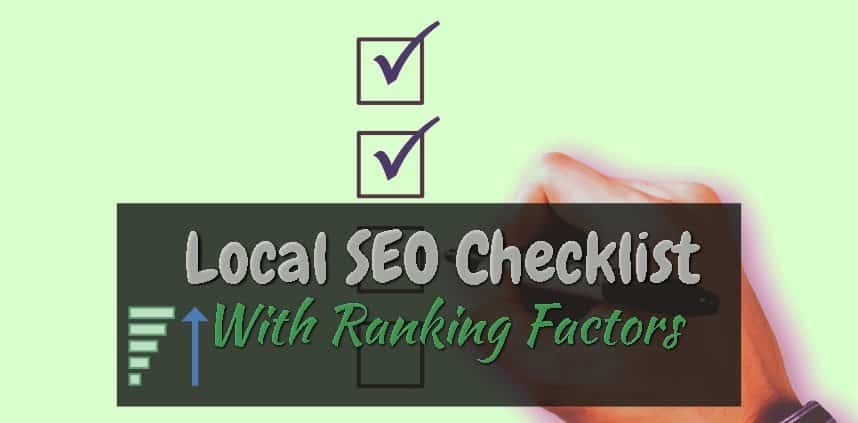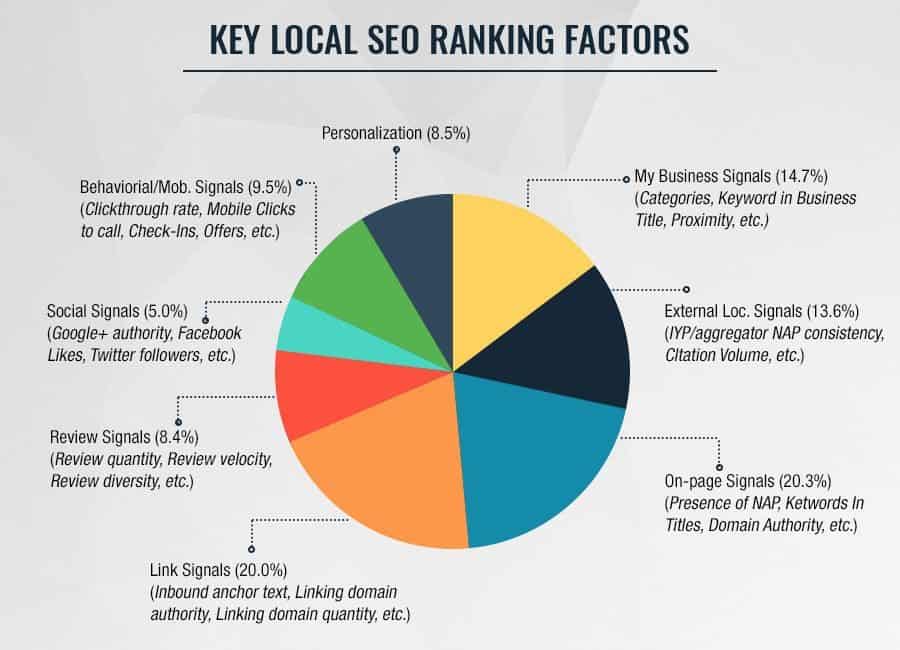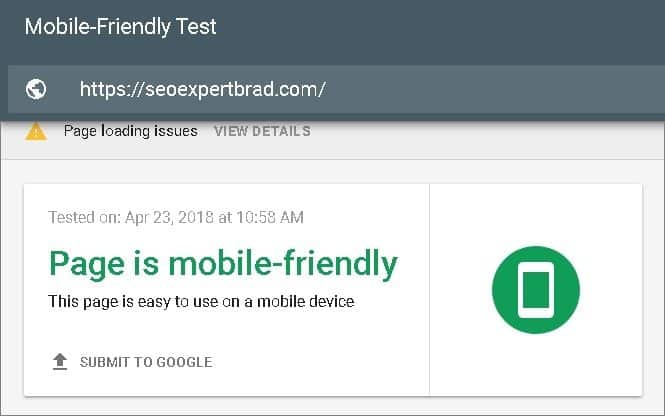My Local SEO Checklist To Dominate Search
As a business owner, Local Google search engine marketing is more important than ever. Google’s algorithm prioritizes hyperlocal results. That means that focusing on local search marketing is a must.
As you know, digital marketing can be complicated.
Good local SEO includes on-site and off-site techniques.
It also requires careful reputation management as reviews are now very much a ranking factor on Google for 2019.
I have put together this local SEO checklist to help businesses drive more customers. In the end, I reveal my top local ranking factors.
Top Ranking Signals for Local Search
You can take several of these signals and move them up or down a few positions.
Proximity: How far is the searcher from your business or registered address on Google Maps? This plays a significant factor in where you rank.
Reviews: Reviews send a strong signal to Google that you are a real, quality business. You should have a consistent strategy to get more Google reviews.
Citations and Consistency: NAP. The last thing Google wants to do is provide the wrong address or phone number.
Domain Authority: Domain trust matters, but not as much as for organic listings.
Google My Business Catagory: Selecting the proper category or categories that reflect your services.
Keywords in Business Title: Although you may see local businesses using false spammy names, it is only a matter of time until Google cleans up the local search rankings. Forget exact match domains. Consider a keyword in your domain name, especially if it works with your brand. Think long term.
My 2019 Local Search Checklist
Make Sure Your Website is Mobile Friendly
Google prioritizes mobile-friendly sites. Since mobile searches surpassed desktop as of 2015, it is not surprising.
- Use Google’s checker to check your mobile friendliness.
- If necessary, update to a mobile-responsive theme.
You will lose leads and rankings if your site is not mobile-friendly.
Optimize Your Google My Business Listing
You already know that your Google My Business listing is essential for local SEO.
Here are the specific steps to take to optimize your GMB:
- Claim your listing. Learn how to verify a Google my business listing.
- Remember that multiple locations should each have their own listings.
- Enter an accurate business name. Don’t add keywords or alter it in any way.
- Enter your complete physical address. The information should match your NAP.
- If you have a service-area business, choose that option. Google will not display your address but will use the area in miles you provide.
- Enter your local phone number. Do not use toll-free numbers or tracking numbers.
- Enter the URL of your website. If you are setting up multiple locations, link each GMB page to the page for that location.
- Choose the categories that best suit your business. Make sure to pay attention if your products/services vary by location.
- Add photos of the interior and exterior of your business. This is not the best use of Royalty Free Stock Images. Go with real, unique photos. They build trust with Google and your customers.
- Add additional information, such as prices and hours of operation.
Optimize Your Content For Local SEO
The content on your site can make or break you.
Here’s how to make sure it is the former:
- The content of each page should be unique, no duplicate content. All content should support the theme and topic of that page.
- Aim to have 500+ words of local content per page.
- Use hyperlocal keywords and references whenever possible. If you have multiple locations, describe the products and services available.
- Use local customer testimonials on location pages.
Above all, make sure your content is readable and informative. It should be written for people, not machines.
Include or Embed Google Maps
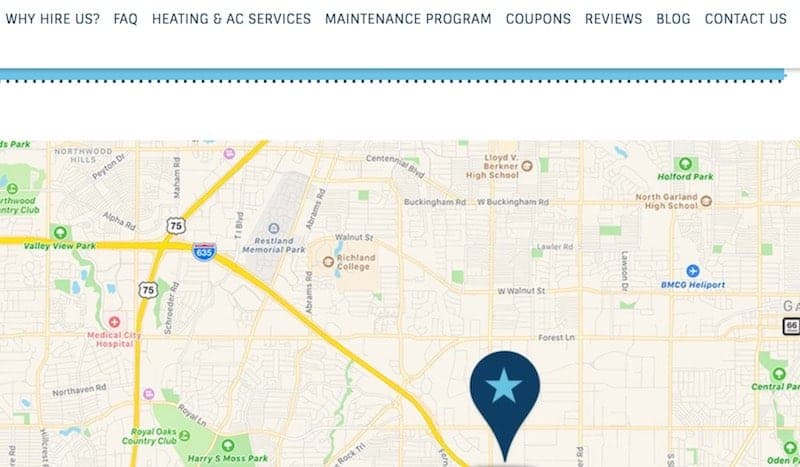
Google maps help customers find local businesses.
Here’s how to use them:
- If you have one location, embed your Google map on your Contact page.
- For multiple locations, embed a Google map of each location on its proper landing page.
Verify that your address and phone number is easy to find
Customers should not have to look for your contact information.
It should always be easy to find, no matter where they are on your website. I always start with ensuring it can be seen on the front page without scrolling on both mobile and desktop.
Optimize Your Title Tags

Example Title and Meta Description Tags
Your title tag dictates what will display on Google when someone searches your keywords.
Do the following:
- Write unique titles for each page on your site. Include your primary (local) keyword for that page.
- Keep each title to less than 60 characters. This ensures it will display correctly in Google Search Results.
By optimizing title tags, searchers and Google have a clear idea of what your page is about.
Unique Actionable Meta Descriptions

Each page on your site also needs a meta description. This is the description that appears beneath the title on Google. It tells people what they will find on your site. You will need to:
- Write clear meta descriptions for every page, using local keywords as natural.
- Keep your descriptions from 130-165 characters. Include keywords and city, without being spammy.
A poorly-written meta description can hurt your click thru rate. Be concise, clear, accurate, and include a call to action.
Optimize Heading Tags
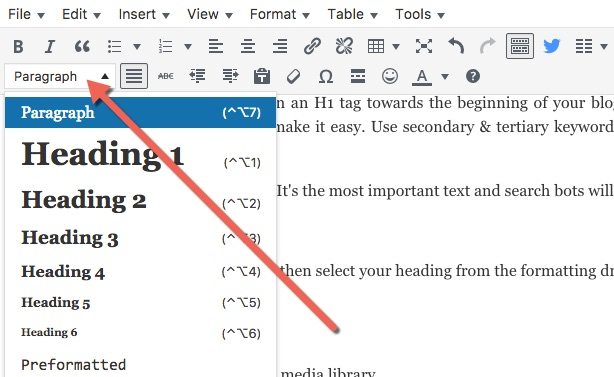
Heading tags help to format the content on your site, for search engines and users alike. Here’s how to make the most of them:
- Put at one H1 tag on each page.
- Include your primary keyword in it, preferably toward the front. Using H1 headings correctly helps Google identify your most important keywords and the topic of each page.
- Use H2 and H3 headings as needed.
Structured Markup
Schema markup is code that allows you to add relevant information about your business.
Here’s how to take advantage of it:
- Add structured data markup to your homepage if you have only one location.
- If you have several locations, put local business schema on each location’s page.
It is easy to add schema markup, and it can make a big difference in your on-page search engine marketing.
Manage Your Online Reviews
According to Bright Local’s survey, 97% of all consumers read local reviews in 2018.
Here’s how to make the most of your customer reviews:
- Make sure your local business is listed on major review platforms. These include Google my Business, Yelp, Angie’s List, and social media such as Facebook.
- Identify any industry-specific or local review sites and claim your listings there, too.
- Assign someone to monitor your online reviews. All customer reviews deserve a response, even good ones.
- With positive reviews, you can simply thank the customer and say you hope to see them again.
- With negative reviews, apologize for their bad experience. Then, reach out to them privately and resolve the issue. In many cases, this will inspire the reviewer to revise their review.
- Put a system in place to request reviews from your customers. You may ask them in person. Alternatively, you may give them a handout or reach out to them via email. Note, Yelp has rules against asking for reviews.
- Put links to your review pages on your web site to make it easy for people to write reviews.
- All responses to reviews should be professional and timely.
Verify NAP Consistency
NAP = name address phone number
Your name, address and phone number should be on each page of your site.
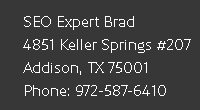
NAP consistency plays a significant role. In fact, it was mentioned many times in my Local SEO Tips roundup.
If you have multiple locations, create a unique page for each one. Then, put the NAP listing of the location in the footer of its page.
Build Local Citations
We already talked about NAP Consistency. Now it is time to build your citations.
Here’s what to do:
- Create a unique local citation for each businesses location. Include the physical address and phone number.
- Eliminate any listings that use a PO Box. Only physical addresses help with local SEO.
- Standardize all abbreviations. If you use Ave instead of Avenue, do it consistently.
- Locate inaccurate or duplicate listings.
- Contact pages and webmasters for inaccurate listings. When possible, correct them. If not, have them deleted.
- Submit your details to these four data aggregators: Acxiom, Factual, Infogroup, and Neustar/Localeze.
- Find niche directories and submit your website and citation to them. Examples include Yellow Book and Superpages. There may be others relevant to your industry and location.
- Get listed in local business listings
The goal here is to standardize your listings. You can add listings, but only as they are relevant.
Hyper-Local Link Building
Now you will want to build quality local links. Local link building gives your site authority and makes it easy for customers to find you.
Here’s what you need to do:
- Reach out to local blogs, offer to collaborate on blog posts.
- Connect with other local business owners. Create partnerships to help one another out.
- Join your city’s Chamber of Commerce and get listed on their site.
- Join the local BBB chapter and get your site listed there, too.
- Attend and sponsor local events and get your local business listed on the websites.
- Build relationships with local media outlets. Submit press releases when something notable happens to your company.
This type of white hat link building connects you to the community.

